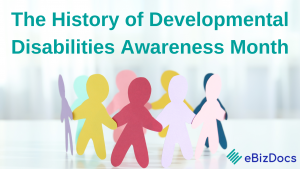
In 1987 President Ronald Reagan proclaimed March “Developmental Disabilities Awareness Month.” The deinstitutionalization movement of the seventies and early eighties had laid the foundation for significant social change, and the presidential proclamation called upon Americans to provide the “encouragement and opportunities” necessary for people with developmental disabilities to reach their potential.
As those citizens began living within the general community in larger numbers, programs to provide career planning, job coaching and supported employment began to emerge. The idea that individuals with developmental disabilities could become productive members of the workforce was new to many people, and entrenched preconceptions had to be overcome.
What Happened Next
Advocates recognized a moral imperative to engage individuals with developmental – and other – disabilities. With passage of the Americans with Disabilities Act in 1990, workplace discrimination against people with disabilities became sanctionable.
The expectations of young people with developmental disabilities and their parents began to shift. Productive, self-directed lives within the community increasingly became the goal, and (increasingly) an obtainable goal. At the same time, due to improvements in healthcare, people with developmental disabilities were living longer, leading to questions about the lifestyle of “retirement-age” individuals.
In short, the national conversation began to address the full spectrum of services needed for people with disabilities to live secure, fulfilling lives. Passage of the Individuals with Disabilities Education Act (IDEA) in 2004, further cemented the resolve of self-advocates and their supporters. With its guarantees of early intervention, special education, and services to transition high schoolers into adulthood, IDEA opened a world of possibilities.
Furthermore, Congress passed the Americans with Disabilities Act Amendments Act of 2008 (ADAAA) in response to several Supreme Court decisions that narrowly interpreted the ADA’s definition of disability, thereby making it difficult to prove that an impairment was a “disability”. The ADAAA made it easier for an individual’s seeking protection under the ADA to establish that they have a disability as defined within the law.
In 2014, The Workforce Innovation and Opportunity Act (WIOA) was signed into law. The WIOA was a landmark legislation, designed to strengthen and improve the nation’s public workforce system and help get Americans, including youth and those with significant barriers to employment, into high-quality jobs and careers and help employers hire and retain skilled workers. This law was instrumental in helping individuals with disabilities gain access to employment, training, and support services.
These are just a few important milestones for people with intellectual and developmental disabilities. While Developmental Disabilities Awareness Month is a time to celebrate the progress that has been made, it’s also a time to acknowledge and address the work that still needs to be done. If you’re looking for ways to participate in DD Awareness Month in your community, visit here.
(Source: Robert B. Fleming, CELA specialneedsalliance.org, set-works.com)

